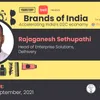Why WOW Skin Science’s Manish Chowdhary is backing a hybrid model to build a successful D2C brand
At YourStory’s Brands of India, WOW Skin Science Co-founder Manish Chowdhary spells out strategies that helped the skincare startup thrive, and its ambitious plans to go from 12,000 to 50,000 stores in the next one year.
The COVID-19 pandemic may have pushed almost every brand online to drive business, but Manish Chowdhary, Co-founder of , feels that India’s offline story is here to stay because of the country’s population and the fact that “it is a long way before ecommerce really settles in India”.
That said, Manish believes that the next decade will see tons of brands coming from India. Internet penetration will allow them to grow with consumer personalisation and create a competitive D2C space in the country.
Speaking at YourStory’s Brands of India event, he said: “I'm a strong believer that when you're creating a brand, you should be sold everywhere, anywhere. If you only sell on one channel, and you kind of don't have a poll on the other one, a lot of work has to be done on building the brand. Offline is our largest and the ultimate frontier,”
He added that a huge portion of the population may interact and engage with a brand online but would prefer the experience of visiting offline stores to make a purchase.
WOW Skin Science receives a lot of love from consumers in India and beyond, but Manish and his team believe that “the brand would really arrive when it is well established offline”.
With an offline presence in over 12,000 stores in India, Manish spelled out the brand’s plans to reach 50,000 stores in the next 12 months - with “precision, patience, and discipline”.
Balancing a hybrid model

Manish said the ongoing challenge is to be relevant on both online and offline channels. “We don’t want to be recognised as an only ecommerce brand,” he said. “Building a business model equipped for both channels needs a lot of specialisation. We treat each channel and opportunity as a startup within a startup.”
According to Manish, more and more offline legacy brands are building digital capabilities to remain in the game as consumer choices keep increasing and competition deepens.
For many others looking to get discovered by consumers, the entrepreneur said listening to customer wants and needs can help cut through the clutter. Word of mouth can also play a huge role.
"It's always thinking about what your competitor does not have and what you can give a customer as that additional USP to be discovered and accepted," he said, adding that community building was also an integral part of building a brand.
Over seven years into the journey from starting off as a supplements brand to trying almost everything in the health and beauty space, Manish said the company continued to operate as one large startup and is currently in an interesting phase of “being very responsible for what it delivers to customers”.
Beyond the metros
The entrepreneur stated that the growth of D2C brands in India benefits Tier II and III cities in India, which lack access to such products and experiences. This region is also of immense importance and focus for his own D2C brand.
“If you really ask me, Tier II is one of our largest today because they want good products but the region is under-distributed. At a click of a button today, at the speed at which we are delivering, you will get inventory in the next day or in 48 hours,” he said, adding that consumer loyalty was also the highest there.
Behind the scenes, the brand claims to leverage tech and data to study what kind of products or content would do best in different pin codes (regions).
“I must urge everybody to spend a bit more time on customer experience because you got one chance with him. He's buying you one time and that's the only one time you can build a bond with him. So packaging is extremely vital. Be clear about your product, what it can and cannot do,” Manish said.
Brands of India is a YourStory initiative to catalyse the growth of India's D2C economy. The initiative will bring together D2C ecosystem stakeholders, including brand builders, D2C startups, investors, corporates, and policymakers, to discover, build and help daring entrepreneurs create an additional 500 Brands of India in the next three years.
To know more about this initiative and the D2C ecosystem, visit brandsofindia.yourstory.com
Edited by Teja Lele









